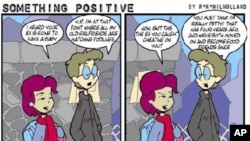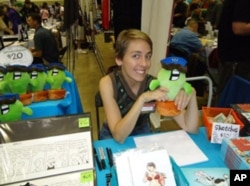When Randy K. Milholland was laid off 10 years ago, he used some of his idle time to create a Web comic called, "Something Positive," featuring a lead character named Davan.
“When I started the comics off, he was who I had been a couple of years earlier," Milholland explains. "He was very sarcastic, always negative. He would rather make snarky retorts than actually act to make things better.”
Even after he landed a new job working for an ambulance company, Milholland kept the comic strip as a hobby.
“When I was doing comics every other week, therefore I was missing updates," he recalls. "Readers were complaining about it. So I kind of issued a challenge that if they wanted to pay my salary from my day job, I would quit my day job and focus only on the comics.”
They did, so he became a full-time comic artist on the Web and his website now averages 215,000 hits a day.
According to Milholland, he’s one of a growing number of Web comic creators. There are 36,000 worldwide by some estimates. It used to be the goal of comic strip artists to land contracts with newspaper syndicates so they could sell their comics to newspapers. But now, for many, syndication is no longer the goal.
Milholland earns income from advertising and sales of t-shirts and other merchandise, all online.
So does Danielle Corsetto, creator of "Girls with Slingshots." Corsetto, who drew her first comic strip when she was eight years old, updates "Girls with Slingshots" five times a week to satisfy fans, who number about 90,000 a day.
She says Web comic artists are profiting from the free speech the Internet offers.
“Part of the reason, I think, that we’ve become successful is that we put a lot of our personality directly into the strip. People who are reading our comics are really enjoying that. People want to know a lot about the personal lives of the people who are creating the comic strips that they love.”
College graduate Laura Weiner, who follows about 35 comic strips online, is a big fan of Web comics. “It’s somebody putting themselves on the Web for everyone to see and hoping people like it. Reading them online, it’s a little more intimate than just going to a comic store and purchasing a mass-produced comic book."
Feedback from fans is what keeps Web artist Milholland going, as does the interaction with other artists.
Courtesy: girlswithslingshots.com
“We don’t have a guild per se. We don’t have a union because we don’t really have anyone who hires us that we need to negotiate rights with," he says." But we do have a lot of friendships. The nice thing is a lot of us don’t see it as competing against each other because since Web comics are free, people can read as many as they want.”
And they are, says artist Michael Uslan, who has taught "Comic Book Folklore" at Indiana University. He says Web comics are getting noticed all around. “I do know that many of the studios and talent agencies and comic book companies troll these websites."
With more people following them online or downloading Web comic strips onto their mobile devices, the artists say time - and technology - are on their side.

















